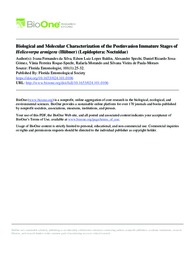Biological and Molecular Characterization of the Postinvasion Immature Stages of Helicoverpa armigera (Hübner) (Lepidoptera: Noctuidae).
Biological and Molecular Characterization of the Postinvasion Immature Stages of Helicoverpa armigera (Hübner) (Lepidoptera: Noctuidae).
Author(s): SILVA, I. F. da; BALDIN, E. L. L.; SPECHT, A.; SÓSA-GOMEZ, D. R.; ROQUE-SPECHT, V. F.; MORANDO, R.; PAULA-MORAES, S. V. de
Summary: Resumo: Neste estudo foram realizadas a caracterização molecular e a comparação da biologia de estádios imaturos de Helicoverpa armigera Hübner (Lepidoptera: Noctuidae). Foram estabelecidas três colônias desta espécie, a partir da coleta de insetos oriundos dos estados de São Paulo, Bahia, e Distrito Federal, em plantas de citros, algodão e milho, respectivamente. Análises genética foram conduzidas usando microssatélites de forma a verificar a similaridade genética dos insetos de cada colônia. A biologia de imaturos foi estudada sob condições de laboratório (T = 25 ± 1 °C, UR = 70 ± 10%, fotoperíodo = 14:10 h L:D). A análise de microssatélites revelou variabilidade genética nos espécimes amostrados e que o agrupamento dos indivíduos foi independente da origem geográfica. Uma dieta artificial foi utilizada e validada durante o estudo de biologia comparada. Amostras de cada um dos ingredientes da dieta artificial foram analisadas quanto à pureza, tamanho de partícula e presença e quantidade de agregados. As viabilidades médias das larvas e pré-pupas nas três populações foram semelhantes. E o tempo total de desenvolvimento total (ovo a adulto) não foi significativamente diferente. Abstract: We performed molecular and biological characterizations of immature stages of Helicoverpa armigera Hübner (Lepidoptera: Noctuidae) using insects from different states in Brazil, and different host plants. Three laboratory colonies of H. armigera were established with insects from the states of São Paulo, Bahia, and Distrito Federal, that were collected from citrus, cotton, and corn, respectively. For each colony, microsatellites were used to assess genetic similarity among insects. The biology of the immature stages from each colony also was compared under laboratory conditions (25 ± 1 °C, 70 ± 10% RH, 14:10 h [L:D] photoperiod). Microsatellite analysis revealed genetic variability in sampled specimens and that the grouping of individuals was independent of the geographic origin. The utility of an artificial diet was validated during the comparative biology experiment, and the ingredients of the artificial diet were analyzed for purity, particle size, and the presence and quantity of aggregates. The mean development times of the larvae and pre-pupae from the 3 locations were similar, and mean total development time (egg to adult) was not significantly different.
Publication year: 2018
Types of publication: Journal article
Unit: Embrapa Cerrados
Observation
Some of Embrapa's publications are published as ePub files. To read them, use or download one of the following free software options to your computer or mobile device. Android: Google Play Books; IOS: iBooks; Windows and Linux: Calibre.
Access other publications
Access the Agricultural Research Database (BDPA) to consult Embrapa's full library collection and records.
Visit Embrapa Bookstore to purchase books and other publications sold by Embrapa.

